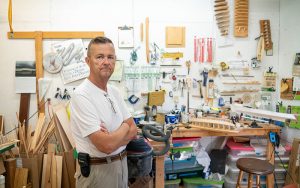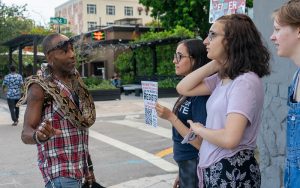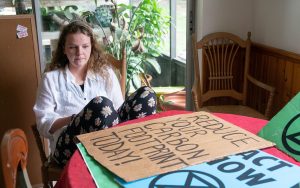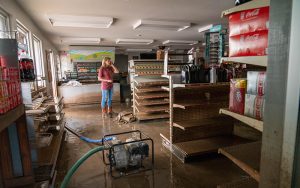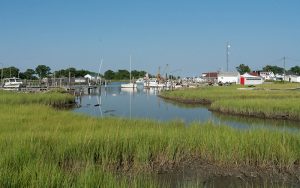- Slug: BC-CNS News21 Climate Change. 1,940 words.
- 14 photos and captions below.
- Video here.
By Jordan Laird and Jordan Elder
News21
SMITH ISLAND, Md. – The Eastern Shore of Maryland, where crab pots line the docks and boats are stored in backyards, is one of most vulnerable places in the U.S. to the effects of rising seas, climate scientists say.
But like many Americans, only about 40% of people living along the Chesapeake Bay believe global warming will harm them personally, according to Yale University’s Climate Opinion Maps 2018. That’s despite the fact that the same study showed almost two in three Americans believe global warming is affecting weather.
For more than three decades, scientists have pointed to worsening floods, more powerful hurricanes and larger wildfires as evidence of climate change – but many Americans remain unconvinced.
Eddie Somers, who recently retired as captain of an icebreaker, has some doubts.
“I disagree with the rates. I just don’t buy it,” he said of flooding and sea-level rise predictions.
Somers, who was born on Smith Island, resides in Crisfield, a 45 minute boat ride from his hometown. He trusts his own experience with Chesapeake Bay as a predictor of the future.
“We see a lot of holes in environmental science because we live it,” he said. “It’s based on what I’ve seen and what my father saw and what my grandfather saw.”
Environmental scientists report that about a dozen communities on the Eastern Shore, including Crisfield and Smith Island, already are coping with disruptive flooding. Although it affects just 10% of Crisfield today, chronic flooding is projected to affect more than half of the town within the next 20 years, according to the Union of Concerned Scientists, a nonprofit American group that promotes evidence-based solutions to pressing global issues.
Somers’ skepticism of the science is common, but not universal, in communities on the Chesapeake Bay.
“I always tell my students, ‘I don’t choose to believe in climate change,’” said Patricia Benner, who teaches earth sciences to children from Crisfield and Smith Island at Somerset Intermediate School in nearby Westover.
“I understand the data … the numbers are there. All you have to do is look at it critically and then you can make your own decision,” Benner said.
Some teenagers from across the country have made their decision and are persuading others to do the same.
Jamie Margolin of Seattle was only 15 in 2017 when she became frustrated by a string of what she calls “unnatural disasters” that hit the U.S.
“The media was not paying proper attention to them and making the connection between these natural disasters and climate change,” Margolin said.
Within a year, she and a few friends organized Zero Hour, a youth-based climate action organization, which held its first summit this summer. They chose Miami, a city often cited as ground zero for climate change because of frequent storms, flooding and low elevation.
“We’re probably one of the most vulnerable places in the country for sea level rise,” said Brian Soden, a professor at the University of Miami Rosenstiel School of Marine and Atmospheric Science. “It’s not like we can build a barrier or wall as the sea level continues to rise because it will just rise up through the bedrock.”
Miami-Dade County also is one of the few places in the country where a majority of the population – 54% – believe climate change will harm them personally, according to the 2018 Yale study.
Margolin and other activists peppered Miami with Zero Hour stickers and flyers to promote the summit, recruiting other young people to join their fight in the process. About 350 attended the summit, which featured workshops on climate science and leadership training.
Young people around the country are organizing around climate change, Margolin said, in part because they will live long enough to see the impacts.
Before joining Zero Hour, Sohayla Eldeeb, 18, already had lived through multiple hurricanes. In New Jersey, she watched her family’s house get torn apart by Hurricane Sandy. After her family moved to Ormond Beach, Florida, she lived through Hurricanes Matthew, Irma and Michael, as well as other smaller tropical storms.
“I’m just constantly living in this threat, and that’s why it’s become so personal to me,” she said.
Rachel Collins has lived in Homestead, Florida, south of Miami, for all her 21 years. Although she’s heavily involved in several climate action organizations, she said her parents never understood her concern. She showed them elevation maps illustrating that most of South Florida is just a few feet above sea level and will be underwater within her lifetime.
Her mother, Deborah Collins, said she only recently understood Rachel’s climate change concerns, and now participates with her in South Florida demonstrations.
“When you’re raising a family, and you’re busy in your work, and you’re trying to take care of kids and pay a mortgage and all this stuff, you’re not thinking about other things,” she said.
City of Miami Beach Mayor Dan Gelber said he trusts his eye. Areas of the city regularly experience what’s called sunny day flooding, or tidal flooding. There’s no weather event, but the tide rises and low lying areas flood.
Miami Beach is in the middle of a $500 million project to raise roads and install pumps to clear stormwater and control flooding of city streets.
“It’s obvious that just one city isn’t going to change whether or not we have sea-level rise,” Gelber said, adding that state and federal governments need to pass legislation to lower carbon emissions and make other environmental changes.
“My job as the mayor is to make sure we’re doing something to address this in an informed way,” he said. “I believe this is a surmountable challenge.”
Most Americans simply are not engaged with the topic of climate change. The Yale study said that in 2018, about 35% of Americans reported discussing global warming at least occasionally.
Climate change is causing record precipitation in the Midwest, resulting in chronic river flooding in recent years, according to research from the Union of Concerned Scientists.
This hasn’t turned people in at least one Arkansas community into climate change believers. Although 63% of Arkansans believe climate change is happening, only 36% believe it will negatively affect them, according to the Yale study.
Until this year, the Arkansas River’s highest recorded level was 38.1 feet, in 1945. But this spring, after torrential rains upstream, the river crested at 40.79 feet, according to the National Weather Service.
That record almost cost Jason Trantina his business.
Trantina has operated the Toad Suck One-Stop since 1997 and has owned it since 2006. The gas station and convenience store, the only store in town, normally serves as a hub for Toad Suck’s 288 residents. Despite being steps from the Arkansas River, the store had never flooded before this summer.
He and his employees battled the river, constructing barricades of dirt and concrete blocks and pumping out water. But after days of struggle, the river won.
“I don’t know if I’m fully on board with the climate change … I think everything kind of comes in spells,” said Trantina, who attributes this round of flooding to intense rain upstream in Oklahoma and mismanagement of the Arkansas River levee system.
State Sen. Jason Rapert, a Republican representing Bigelow, also is a skeptic. Much of his central Arkansas district was submerged under the historic flooding, including his own 67-acre hay and feed farm.
“You go through seasons and cycles where you have more turbulent weather. All we know is the fact that we’re in a cycle now where we’ve had some,” he said.
Floods didn’t used to break records every year, said Astrid Caldas, a senior climate scientist with the Union of Concerned Scientists.
“If you look at the flooding patterns for the past five years, I mean, every March, April, the floods start,” she said. “And it’s like record-breaking huge floods and people displaced.”
Last spring’s record flooding of the Arkansas River near Toad Suck also caused nearby Lake Conway to overflow, engulfing lakefront homes. (Photo by Jordan Laird/News21)
Kristina Dahl, another senior climate scientist with the group, said she doesn’t know how to convince skeptics that climate change is intensifying natural disasters.
“If I could answer that question, we’d be in a much better position in our country today. I’m really not sure,” she said.
Dahl said it can be difficult to connect gradual changes to a larger picture. It’s easier to attribute subtle changes to familiar weather patterns.
That’s the case with Donald Willey, a former Marine living on Hoopers Island, Maryland, on Chesapeake Bay. After Hurricane Isabel ravaged the island in 2003, he stumbled upon a Revolutionary War era graveyard. Literally.
“All of a sudden, my foot hits something and it was hard, solid. I pulled weeds away, and when I did, there was a headstone. … A little child’s headstone,” Willey recalled.
In 2003, a 40-foot barrier of land separated the headstones and the bay. Now, headstones and tombs routinely topple directly into the water.
The shoreline changes with every storm, said Willey, who moves the graves and headstones to higher ground to preserve the legacy of the dead.
Willey said he believes in climate change, but erosion, not rising seas, will be to blame for the graveyard’s demise. Erosion affects the land with or without climate change, he said, but the increase in storms may enhance the problem.
Experts don’t have a lot of solutions for how to persuade skeptics, but there has been extensive research on why so many Americans don’t believe the science.
The short answer, according to a 2018 study by the Annenberg Public Policy Center of the University of Pennsylvania: Americans view natural disasters through a political lens. “Enduring Extremes? Polar Vortex, Drought, and Climate Change Beliefs,” conducted from 2010 to 2015, found that partisan leanings largely determined whether people linked climate change to the extreme weather they were experiencing.
Psychologists point to “motivated interference” as one of the myriad reasons people don’t accept the science. In “Psychology Today,” psychiatrist and neuroscientist Jack Gorman and his daughter, Sara Gorman, wrote that motivated interference occurs “when we hold a specific bias to ignore evidence.” In terms of climate change, this can include resentment if the government were to tax individuals and spend the revenue on carbon mitigation efforts.
A 2018 study by the School of Communications at Ohio State University called “Unintended Effects of Emphasizing the Role of Climate Change in Recent Natural Disasters” examined how the perception of risks was affected by news stories about climate change’s influence on natural disasters.
“Skeptics experienced greater resistance” to articles that mentioned climate change playing a role in natural disasters, Ohio State researcher Graham Dixon said, which affected their risk perception of the disaster itself.
Dixon said extreme weather events are “a great illustration of the effects of climate change” and should be sufficient to convince skeptics, but research shows that “it may not move the needle all that much in terms of changing people’s beliefs about climate change.”
In South Florida, Deborah Collins, who now joins her daughter Rachel in climate-change activism, said some adults actively choose not to deal with the issue.
“You’ve got a lot of other folks that are my age or older that are like, ‘We’re not going to be here, we’re going to be gone,’” said Collins, who’s in her mid-50s.
For the sake of her children’s generation, she disagrees with that mindset.
“This is their legacy. This is what they’re going to be left with. If you made a mess or you did something wrong, you have to clean it up.”
Jordan Elder is a Hearst Foundation Fellow.
This report is part of State of Emergency, a project on disaster recovery produced by the Carnegie-Knight News21 program. For more stories, visit stateofemergency.news21.com.
For more stories from Cronkite News, visit cronkitenews.azpbs.org.
^_=

